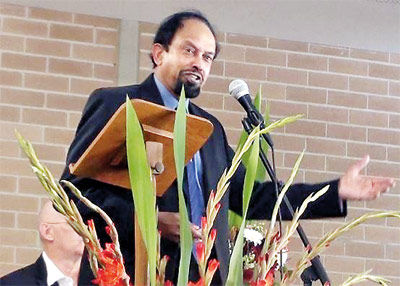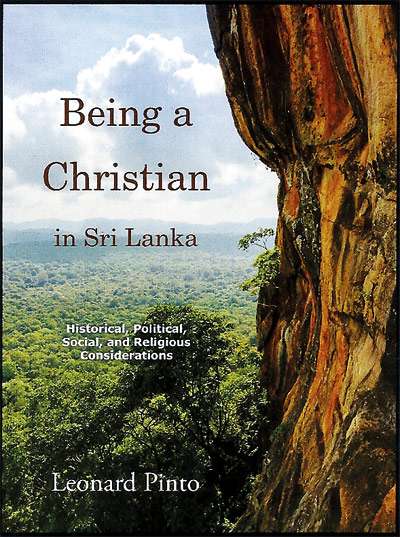The interplay of religions from then to now
View(s):Dr. Leonard Pinto’s book, “Being a Christian in Sri Lanka: Historical, Political, Social and Religious Considerations” was recently launched in Sydney.

Dr Leonard Pinto introducing his book at the launch
The chief guest was Fr. Gerald Gleeson PhD, former professor of Philosophy and Theology at the Catholic Institute of Sydney and current Vicar General of Sydney Catholic Archdiocese. Special guest was Lal Wicrematunga, the Sri Lankan Consul General in Sydney.
Being a Christian in Sri Lanka is published by Balboa Press, Hay House USA, and distributed by Barnes & Noble and Amazon worldwide. The 570-page book with 16 Figures and 5 tables contains more than 450 references.
The primary focus of Pinto’s book examines the past and present socio-political and religious issues encountered by Christians in Sri Lanka.
Much of the work is placed in the context of the global challenges to Christianity and the Church today arising from the materialistic West, and their potential impacts on Sri Lanka.
Many issues faced by Sri Lankan Christians have historical, political, social and religious roots, and these are considered from an anthropological perspective.
Global issues take the reader beyond the shores of Sri Lanka to the contemporary ‘state-of-the-art’ and diverse fields of knowledge (including morals, science and religion) and their conceptual claims.
These are reviewed in the context of teachings of the Church and the Christian world-view (weltanschauung) today. Hence the book is multi-disciplinary in its approach.
Misconceptions on Christianity and Christians of Sri Lanka have been disseminated in Sinhala and English by various websites, books and media from Sri Lanka.
Pinto’s book explores the truth of many of these claims. The content of the book covers the period from the pre-historic Sri Lanka to January 2015.
Sri Lanka has a recorded Buddhist-Sinhalese history that goes back to more than 2500 years. The dominant Buddhist-Sinhalese civilisation has been intermittently interrupted by a number of South Indian invasions.
These invasions were military, diplomatic and social (such as the marriage of Sinhalese kings to Indian queens). The result was an assimilation of the Hindu religion into the local culture, particularly in the North. Islam came later to Sri Lanka, through the Indian and Arab traders.
During the Sigiriya period in the 5th century AD, there was a notable influence of St. Thomas’ Christians from India and Nestorian Christians from Persia on Sinhalese royal families.
However, it was after the arrival of the Portuguese in 1505 that a large number of natives, including Sinhalese and Tamil kings and members of royal families embraced Catholicism. The reasons for their conversions were diverse.
The Portuguese colonised the maritime regions of Sri Lanka for approximately 153 years, the Dutch for 138 years and the British for 152 years until Sri Lanka achieved independence in 1948.
Contrary to the popular belief, the three colonisers did not initially ‘invade’ Sri Lanka. Rather, the Sinhalese kings and chieftains invited them into the country primarily to help neutralise the Muslim trade domination, fight rival Sinhalese kings, replace an existing coloniser or depose a tyrannical king.
But, once invited, the colonisers fought battles with opposing Sinhalese armies and enforced their presence on the country.
Buddhist-Sinhalese nationalism was born in the wake of South Indian invasions. By unifying the Sinhalese nation, a consolidated front to repel the Indian invaders could be established.
From the 16th century, the Buddhist-Sinhalese nationalism was directed to fight the western colonisers, the Portuguese, Dutch and the British. The Buddhist-Sinhalese movement led by Buddhist monks in 1860s, and later by lay leaders, took an anti-Christian orientation in rhetoric, debates, literature and processions, and in attacks by extremists.
Towards the end of the colonial period, an aspiration to develop a ‘Sri Lankan national identity’ unified Sinhalese and Tamil leaders, who collectively fought to free themselves from British domination.
During the Muslim riot of 1915, when many Buddhist-Sinhalese political leaders were imprisoned or killed, martial law was declared by the over-reacting British Governor Robert Chalmers. It was the Christian leaders, including Sir James Peiris and E. W. Perera and Tamil leaders, including Sir Ponnambalam Ramanathan, who came to the rescue of the imprisoned Buddhist-Sinhalese leaders.
The dynamics of nationalism gradually changed from a ‘Sri Lankan identity’ to a largely ‘Buddhist-Sinhalese identity’. This was primarily the result of the values, quality and thinking of political leaders, and populist strategies designed to win democratic elections. Following independence, the Kelaniya temple became the political nerve centre of the country.
Kelaniya Vidyalankara Pirivena played an important role in politics, dragging the country towards the left and providing a passage for Buddhist monks to enter politics.
Entry of the Buddhist monks into parliament was the result of atrocities by Tamil LTTE against the monks, their devotees and sacred places.
When Sri Lanka (Ceylon) gained independence from the British, it was in an excellent economic shape, with a well-developed civil service, police, legal system, governance, education and infrastructure.
It was in such good shape that the leaders in Singapore wanted to make their country another Sri Lanka.
However, when Singapore’s founder and architect, Lee Kuan Yew, saw the gradual degradation of the quality and values of Sri Lanka after independence, he said that Sri Lanka is a good example for bad policies.
Some of the bad policies were deeply rooted in the flawed ethno-religious divided identities, which claimed more than 100,000 lives within a period of 26 years.
Worse was still to come. A culture of bribery, corruption, nepotism and politicisation of all government systems, including the police, universities, civil service and the legal system meant that the State was run virtually as a family business from 2005 to 2014. The rights of minorities were suppressed and dissidents were abducted; in ‘white vans’ to their death.
Pinto’s book espouses the Sri Lankan identity of all its citizens as the foundation of national identity and the responsibility of State to all its citizens as a primary duty of the State.
At the ethno-religious tier of the hierarchy, Buddhist-Sinhalese identity is given the first place in culture. People are different by birth, appearance, beliefs, politics, abilities, professions and wealth.
Despite this, all people have equal rights in the State and need to be treated as valuable citizens. In attempting to enhance the Sri Lankan identity, the legends and myths that are used to boost the ethno-religious identity are critically assessed.
The content of Pinto’s book is structured to cover issues arising from within Sri Lanka and issues coming from the West, which have the potential to impact Christianity in Sri Lanka.
The first among the chapters that deal with Sri Lankan Christian issues introduces pre-history and history of the Sinhalese.
Chapter 2 focusses on the different forms of colonial Christianity and how Catholicism survived through the efforts of St. Joseph Vaz after the defeat of the Portuguese by the Dutch.
The ethnic war between the Sinhalese forces and the Tamil LTTE, and its impacts on the Church are discussed in Chapter 3. This chapter also refers to Christians as a binding force between the Sinhalese and the Tamils.
Chapter 4 describes the services in education, health and welfare that the Christian institutions in Sri Lanka provide and the difficulties they underwent, following the nationalisation of schools
Chapter 5 describes some of the popular spiritualities adopted by Sri Lankans from a diversity of global Christian spiritualities.
The first chapter that deals with universal issues of Christianity is Chapter 6, which outlines the teachings of Jesus Christ and the historical problems of the Church. Chapter 7 explores the existence of God. Current theories on ethics and the failure of consequential ethics from the ethics of governance and ethics of the ethnic conflict in Sri Lanka are examined (Chapter 8).
The following two chapters (Chapters 9 and 10) focus on Buddhist-Sinhalese nationalism, its impacts on minorities and propaganda activities against Christians, including anti-Christian literature. Chapter 11 considers Christians in Asia as a minority, who live in pluralistic societies, dominated by Buddhists, Hindus or Muslims, and reviews issues of these religions.
Chapters 12 and 13 discuss the impacts of modern philosophies of Marxism, materialism and science on religion. Chapter 14 recognises the value and meaning of prayer for inner peace and tranquility, found in all oriental religions, as well as in Christianity.
The final chapter (Chapter 15) espouses some ideas in moving Christianity forward in Sri Lanka.
Overall, Pinto’s book provides a detailed expose on Christianity in Sri Lanka. Despite its title, it is more than a religious text, and perhaps it is not even a religious text.
It uses religion as the catalyst to examine the complex and intimate relationship among the different religions and how they fit within the social, political and historical context of Sri Lanka, for which reason the publisher has classified it as a reference book on anthropology of Sri Lanka.
| Book factsBeing a Christian in Sri Lanka by Dr. Leonard Pinto. Reviewed by Dr Peter Tate |


